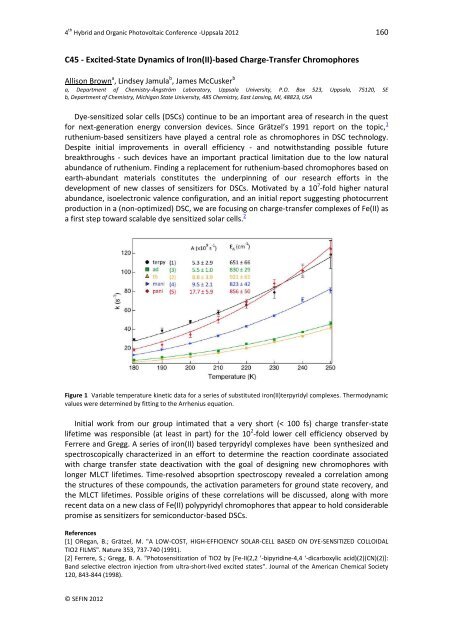HOPV12 - Blogs
HOPV12 - Blogs
HOPV12 - Blogs
You also want an ePaper? Increase the reach of your titles
YUMPU automatically turns print PDFs into web optimized ePapers that Google loves.
4 th Hybrid and Organic Photovoltaic Conference -Uppsala 2012 160<br />
C45 - Excited-State Dynamics of Iron(II)-based Charge-Transfer Chromophores<br />
Allison Brown a , Lindsey Jamula b , James McCusker b<br />
a, Department of Chemistry-Ångström Laboratory, Uppsala University, P.O. Box 523, Uppsala, 75120, SE<br />
b, Department of Chemistry, Michigan State University, 485 Chemistry, East Lansing, MI, 48823, USA<br />
Dye-sensitized solar cells (DSCs) continue to be an important area of research in the quest<br />
for next-generation energy conversion devices. Since Grätzel’s 1991 report on the topic, 1<br />
ruthenium-based sensitizers have played a central role as chromophores in DSC technology.<br />
Despite initial improvements in overall efficiency - and notwithstanding possible future<br />
breakthroughs - such devices have an important practical limitation due to the low natural<br />
abundance of ruthenium. Finding a replacement for ruthenium-based chromophores based on<br />
earth-abundant materials constitutes the underpinning of our research efforts in the<br />
development of new classes of sensitizers for DSCs. Motivated by a 10 7 -fold higher natural<br />
abundance, isoelectronic valence configuration, and an initial report suggesting photocurrent<br />
production in a (non-optimized) DSC, we are focusing on charge-transfer complexes of Fe(II) as<br />
a first step toward scalable dye sensitized solar cells. 2<br />
Figure 1 Variable temperature kinetic data for a series of substituted iron(II)terpyridyl complexes. Thermodynamic<br />
values were determined by fitting to the Arrhenius equation.<br />
Initial work from our group intimated that a very short (< 100 fs) charge transfer-state<br />
lifetime was responsible (at least in part) for the 10 2 -fold lower cell efficiency observed by<br />
Ferrere and Gregg. A series of iron(II) based terpyridyl complexes have been synthesized and<br />
spectroscopically characterized in an effort to determine the reaction coordinate associated<br />
with charge transfer state deactivation with the goal of designing new chromophores with<br />
longer MLCT lifetimes. Time-resolved absoprtion spectroscopy revealed a correlation among<br />
the structures of these compounds, the activation parameters for ground state recovery, and<br />
the MLCT lifetimes. Possible origins of these correlations will be discussed, along with more<br />
recent data on a new class of Fe(II) polypyridyl chromophores that appear to hold considerable<br />
promise as sensitizers for semiconductor-based DSCs.<br />
References<br />
[1] ORegan, B.; Grätzel, M. "A LOW-COST, HIGH-EFFICIENCY SOLAR-CELL BASED ON DYE-SENSITIZED COLLOIDAL<br />
TIO2 FILMS". Nature 353, 737-740 (1991).<br />
[2] Ferrere, S.; Gregg, B. A. "Photosensitization of TiO2 by [Fe-II(2,2 '-bipyridine-4,4 '-dicarboxylic acid)(2)(CN)(2)]:<br />
Band selective electron injection from ultra-short-lived excited states". Journal of the American Chemical Society<br />
120, 843-844 (1998).<br />
© SEFIN 2012


